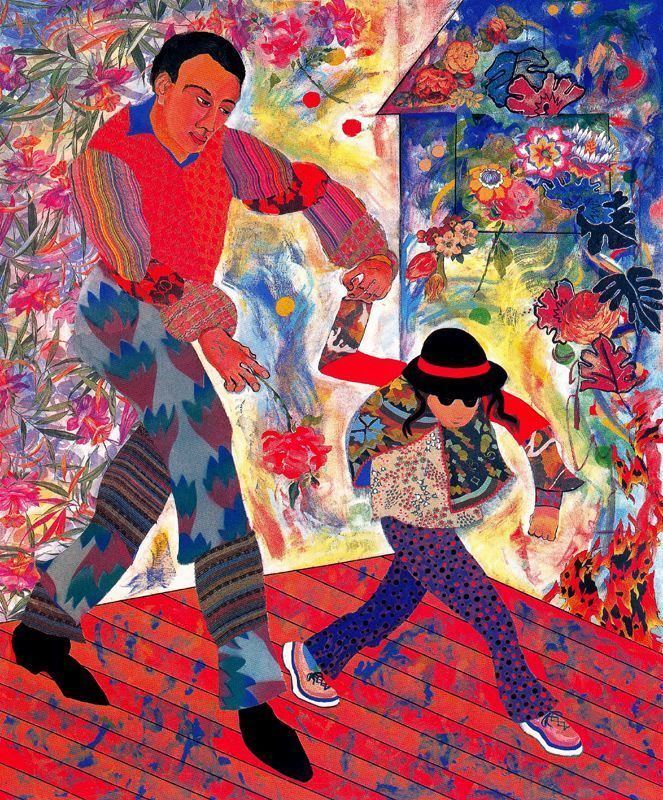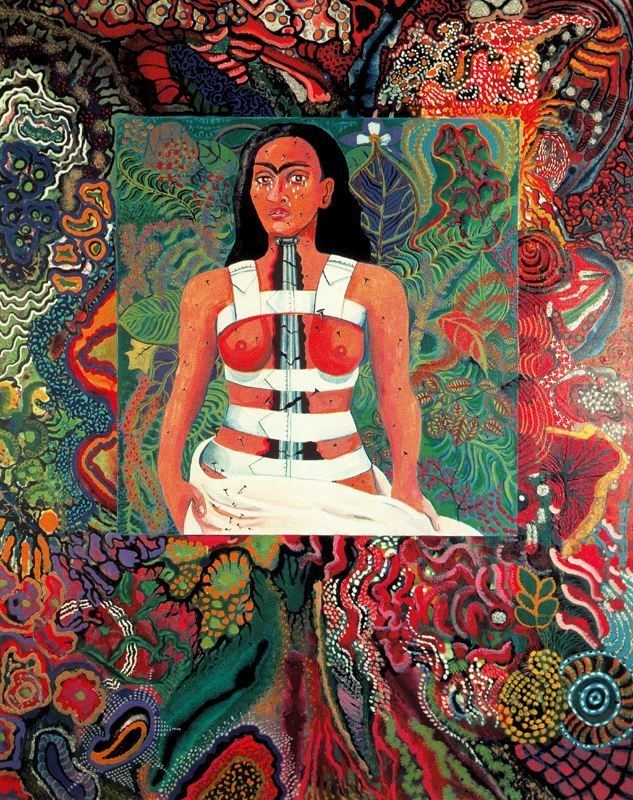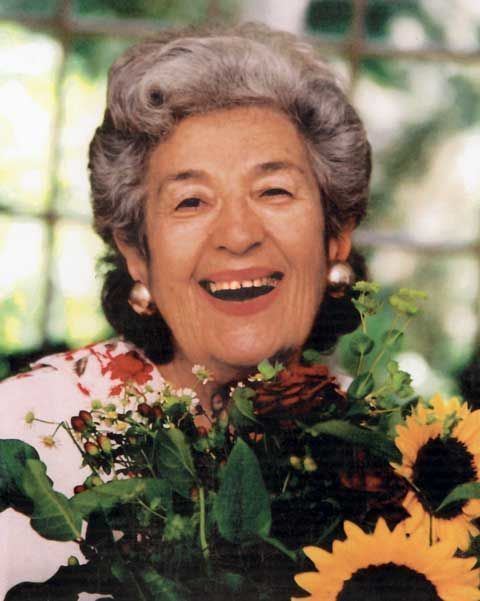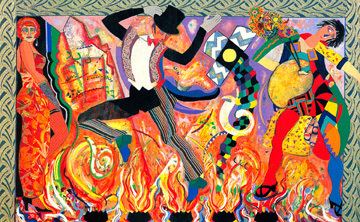Name Miriam Schapiro | Movies !Women Art Revolution | |
 | ||
Known for Painting, Printmaking, Collage Books Agrarian Development and Modernization in the Philippines Education University of Iowa (1949), University of Iowa (1946) Awards Guggenheim Fellowship for Creative Arts, US & Canada | ||
Meet miriam schapiro
Miriam Schapiro (or Shapiro) (also known as Mimi) (November 15, 1923 – June 20, 2015) was a Canadian-born artist based in the United States. She was a painter, sculptor, printmaker, and a pioneer of feminist art. She was also considered a leader of the Pattern and Decoration art movement. Schapiro's artwork blurs the line between fine art and craft. She incorporated craft elements into her paintings due to their association with women and femininity. Schapiro’s work touches on the issue of feminism and art: especially in the aspect of feminism in relation to abstract art. Schapiro honed in her domesticated craft work and was able to create work that stood amongst the rest of the high art. These works represent Schapiro’s identity as an artist working in the center of contemporary abstraction and simultaneously as a feminist being challenged to represent women’s “consciousness” through imagery. She often used icons that are associated with women, such as hearts, floral decorations, geometric patterns, and the color pink. In the 1970s she made the hand fan, a typically small woman's object, heroic by painting it six feet by twelve feet. "The fan-shaped canvas, a powerful icon, gave Schapiro the opportunity to experiment... Out of this emerged a surface of textured coloristic complexity and opulence that formed the basis of her new personal style. The kimonos, fans, houses, and hearts were the form into which she repeatedly poured her feelings and desires, her anxieties, and hopes".
Contents
- Meet miriam schapiro
- Miriam schapiro
- Personal life and education
- Career
- Awards and honors
- List of major works
- Books
- References

Miriam schapiro
Personal life and education

Schapiro was born in Toronto, Ontario, Canada. She was the only child of two Russian Jewish parents. Her Russian immigrant grandfather invented the first movable doll’s eye in the United States and manufactured "Teddy Bears." Her father, Theodore Schapiro, was an artist and an intellectual who was studying at the Beaux-Arts Institute of Design, in New York, when Schapiro was born. He was an industrial design artist who fostered her desire to be an artist and served as her role model and mentor. Her mother, Fannie Cohen,a homemaker and a Zionist, encouraged Schapiro to take up a career in the arts. At age six, Schapiro began drawing.

As a teenager, Schapiro attended was taught by Victor d’ Amico, her first modernist teacher at the Museum of Modern Art. In the evenings she joined WPA classes for adults to study drawing from the nude model. In 1943, Schapiro entered Hunter College in New York City, but eventually transferred to the University of Iowa. At the University of Iowa, Schapiro studied painting with Stuart Edie and James Lechay. She exhibited paintings and prints, which then led her to help form the Iowa Print Group.

At the State University of Iowa she met the artist Paul Brach, whom she married in 1946. By 1951 they moved to New York City and befriended many of the Abstract expressionist artists of the New York School, including Joan Mitchell, Larry Rivers, Knox Martin and Michael Goldberg. Shapiro and Brach lived in New York City during the 1950s and 1960s. Miriam and Paul had a son, Peter Brach, in 1955. Before and after the birth of her son Peter, Schapiro struggled with her identity and place as an artist. Miriam’s Schapiro’s successive studios, after this period of crisis, became both environments for and reflections of the changes in her life and art. During this period Shapiro had a successful career as an abstract expressionist painter in the hard-edge style. She died on June 20, 2015 in Hampton Bays, New York, aged 91.
Career

Schapiro not only honored the craft tradition in women's art, but also paid homage to women artists of the past. In the early 1970s she made paintings and collages which included photo reproductions of past artists such as Mary Cassatt. In the mid 1980s she painted portraits of Frida Kahlo on top of her old self-portrait paintings. In the 1990s Schapiro began to include women of the Russian Avant Garde in her work. The Russian Avant Garde was an important moment in Modern Art history for Schapiro to reflect on because women were seen as equals.

Between 1953 and 1957, Schapiro created a substantial body of work in which she focused on the dominant style of the period: Abstract Expressionism. Miriam created her own gestural language: “painting thinly and wiping out”, in which the wiped area played a significant role as the painted area. Although these works were abstracted such as her work Beast Land and Plenty, Schapiro based them off of black and white illustrations of works by the “old masters”. In December 1957, André Emmerich selected one of her paintings for the opening of his gallery.
Early in her career, Schapiro started looking for maternal symbols to unify her own roles as a woman. Her series, Shrines was created in 1961-63 with this in mind. Beginning in 1960 Schapiro began to eliminate abstract expressionist brushwork from her paintings and began to introduce a variety of geometric forms. It is one of her earliest group of work that was also an autobiography. Each section of the work show an aspect of being a woman artist. They are also symbolic of her body and soul. The play between the illusion of depth and the acceptance of the surface became the main formal strategy of Miriam's work for the rest of the decade. The Shrines enabled Schapiro to discover the multiple and fragmented aspects of herself.
In 1964 Schapiro and her husband Paul both worked at the Tamarind Lithography Workshop. One of Schapiro's biggest turning points in her art career was working at the workshop and experimenting with Josef Albers' Color-Aid paper, where she began making several new shrines and created her first collages.
In 1967, Schapiro and Brach moved to California so that both could teach in the art department at the University of California, San Diego. There Miriam met her close friend David Nalibof, a physicist worked for General Dynamics. Nalibof formulated computer programs that could plot and alter Miriam Schapiro's drawings. This was how her first feminist work, Big Ox #1 from 1968 was created. The diagonals of the represented the limbs of the “Vitruvian man,” while the O depicted the center of the women, the vagina, the womb. This work is described as "a newly invented, body-based, archetypal emblem for female power and identity, realized in brilliant red-orange, silver, and 'tender shades of pink'". The O is also thought to symbolize the egg, which exists as the window into the maternal structure with outstretched limbs.
Subsequently, she was able to establish the Feminist Art Program at the California Institute of the Arts, in Valencia with Judy Chicago. The program set out to address the problems in the arts from an institutional position and focused on the expansion of a female environment in Downtown, L.A. In Womanhouse women were able to turn their invested creativity in rewarding their families with supportive environments toward themselves by allowing their fantasies to take over all rooms. They wanted the creation of art to be less of a private, introspective adventure and more of a public process through consciousness raising sessions, personal confessions and technical training. "('House') became the repository of female fantasy and womanly dreams”. Schapiro participated in the Womanhouse exhibition in 1972. Schapiro's smaller piece within Womanhouse, called "Dollhouse", was constructed using various scrap pieces to create all the furniture and accessories in the house. Each room signified a particular role a woman plays in society and depicted the conflicts between them.
Schapiro's work from the 1970s onwards consists primarily of collages assembled from fabrics, which she called "femmages". In the early seventies, succeeding Schapiro’s collaboration in Womanhouse, she made her first fabric collages in her studio in Los Angeles, which looked much like a room in a house. From the male technological world of computers Schapiro moved into a woman’s decorated house. In this home-like studio, Schapiro monumentalized her fabric cabinet and its significance for women, in a number of large femmages, including A Cabinet for All Seasons. This was her poetic version of the representation of continuous changes and repetitions in all women’s bodies and lives. In her definition of femmage, Schapiro wrote that the style, which simultaneously recalls quilting and Cubism, has a “woman-life context” and that it “celebrates a private or public event.” As Schapiro traveled the United States giving lectures, she would ask the women she met for a souvenir. These souvenirs would be used in her collage like paintings. Schapiro also did collaborative art projects, like her series of etchings Anonymous was a Woman from 1977. She was able to produce the series with a group of nine women studio-art graduates from the University of Oregon. Each print is an impression made from an untransformed doily that was placed in soft ground on a zinc plate, then etched and printed.
Her 1977-1978 essay Waste Not Want Not: An Inquiry into What Women Saved and Assembled - FEMMAGE (written with Melissa Meyer) describes femmage as the activities of collage, assemblage, découpage and photomontage practised by women using "traditional women's techniques - sewing, piercing, hooking, cutting, appliquéing, cooking and the like..."
After 1975, Schapiro returned to New York and with what she made after selling some paintings, she not only had a room but a studio of her own. Decoration and “collaboration,” are central to her artwork and both play a significant role in her house as well as in her studio. The studio became Schapiro’s own room and at moments of great personal conflict, the only connection with her creative self. Her various studios throughout the span of her career have reflected the changes in both the outer and the inner realities of her life. They have expressed her changing self-conceptions in accordance with or in against society, which keeps gender roles separate. Schapiro's studios have also become metaphors for her creative work, as well as spaces in which she could live her life and fulfill her dreams as well.
In the process of taking on different projects, Schapiro’s studio expanded and eventually became portable, following her as she traveled from place to place. It was during the same time of her Oregon collaborative project with the nine women that Schapiro also created her first “Collaboration Series” with women artists of the past. This series combined reproductions of the work of Mary Cassatt and Berthe Morisot with colorful and sensuous fabric borders in patterns inspired by quilts. In Mary Cassatt and Me, Schapiro overlapped her own mental image of her mother with Cassatt's maternal ideal–her mother reading a newspaper.
In her latest paintings Schapiro began exploring her Jewish identity further in her painting. Her painting “My History” (1997) she used the same structure as the “House” project and built rooms of different memories surrounding her Jewish heritage. Her most explicit Jewish-themed statement in art was “Four Matriarchs,” stained glass windows portraying the biblical heroines Sarah, Rebecca, Rachel, and Leah. This was a colorful piece combining identity symbology and her older domesticated art to create the true vision of what high art meant to the public. “Mother Russia” (1994), was a fan piece made by Schapiro that drew from her family's Russian background. She depicts the powerful women from Russia each on a row of the hand held fan with a hat and a veil. She added pieces from each artist work in her “collaborative” style to join them as revolutionary women and give hidden figures praise. Her background in both the Russian and Jewish culture have very much attributed to what Schapiro’s collection of work represents. The foundation and collective use of patterns and colors describe Miriam's work and allow us to see her culture and female voice.
Schapiro's works are held in numerous museum collections including the Jewish Museum (New York), the National Gallery of Art, and the Flomenhaft Gallery. Her awards include the Distinguished Artist Award for Lifetime Achievement from the College Art Association and a 1987 Guggenheim Fellowship. Miriam Schapiro's estate is represented exclusively by Eric Firestone Gallery.
